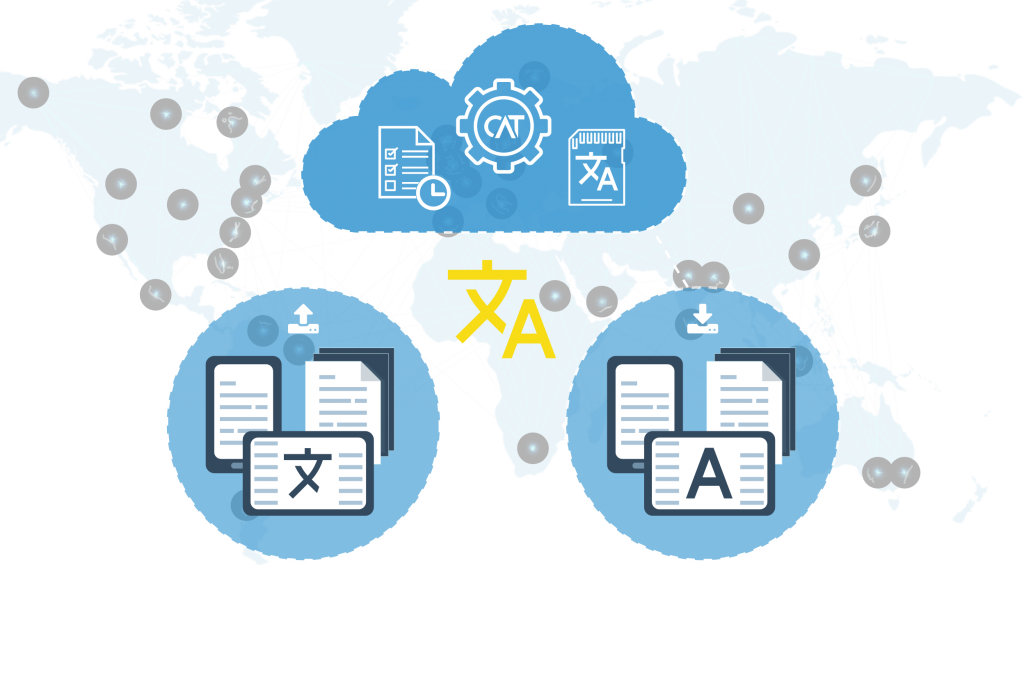
A translation management system (TMS) is a software that automates and streamlines the manual and/or repetitive parts of the translation process, making it much more efficient and cost-effective. A TMS usually contains process management, project tracking, and linguistic technology (explained further down), and is usually integrated with a content management system (CMS). It is a good investment for companies that not only handle a high volume of content that needs to be translated, but also for running those translations projects in parallel.
Functions
Functions vary among TMS’s, and a few of them are listed below:
- File storage/management
- Files are stored within the system rather than in a third party cloud storage system or the like
- Files can be sent through the system, and the vendors can access said files by logging into the system; or, the TMS generates an email template with the files automatically attached
- Source files can also be analyzed within the TMS to determine word count, fuzzy matches, etc.
- Creating project workflows
- Workflows can be created and customized for specific clients and/or projects.
- Project Management
- Project managers (PMs) can monitor project status and make sure the project is on track
- PMs can monitor budgets to maintain a healthy gross margin
- PMs can create Email templates for different stakeholders
- Quote Generation
- As mentioned above, the source text can be analyzed within the TMS based on aspects such as word count and fuzzy matches, and the analysis can be used to create a quote
- Reporting
- Translation performance metrics and vendor performance metrics can be incorporated in the translation evaluation reports
- Reports for stakeholders will be sent out automatically on a regular basis
- Sending reminders
- Automatic reminders can be set up to remind project managers of upcoming, urgent deadlines, and/or sent to the vendors
- Vendor management
- May contain a vendor database, which may include information such as their roles, language pairs, rates, ratings/performance tracking, availability, etc.
- Invoice creation and tracking
- Or, some TMS’s are connected to an invoice management system that is used by the company’s accounting department
Advantages
The advantages of having a TMS include (but are not limited to):
- Automation of much of the translation process
- E.g. file sending, etc.
- Automation saves time spent on projects and cuts down on management costs
- Easy project tracking throughout each step of the translation workflow
- Centralized linguistic assets
- E.g. CAT tool, translation memories, glossaries, dictionaries, machine translation, references, context, etc.
- Facilitation of collaboration among project members
- E.g. translators, reviewers, project managers, accounting team (sometimes), etc.
- Easy project assignment to translators and reviewers
- Integration with other applications, such as:
- CMS: The translation process can start immediately once the content is published or updated
- API: TMS’s cannot do everything; thus, it is convenient to use APIs to add the desired functions
Disadvantages
However, there are a few disadvantages in incorporating a TMS into your workflow:
- A TMS is not cheap and requires a large initial investment, especially for more advanced features
- Also, some TMS’s UI is not very intuitive, especially if they have many advanced features. Hence, TMS buyers might need to ask their engineers to help set up the system. In addition, PMs and system admins need proper training to use the TMS.Therefore, some companies may resist using the TMS, as learning to use the system takes time that they can use on other projects.
- In the event that you decide to switch TMS’s, migration between TMS’s can become quite complicated
- Migration of content can take up to months
- The TMS company intentionally makes the migration difficult, or owns some of the content (check the contract)
Considerations
Given the above discussion, when determining whether or not to use a TMS, it is best to first analyze your company’s localization needs. Some questions to ask are:
- How much content do you need translated?
- How often are you expecting to translate new content? Is your content updated frequently?
- What is your localization budget?
- Do you plan to work with more than one translation vendor?
- Will having a TMS eventually increase your profit margin, or simply financially hurt you?
In the event you decide that a TMS would make localization much more efficient and manageable, then when comparing the different TMS’s on the market, it’d be best to consider what functions in a TMS (and possibly API’s) would add value to your localization process. What are the possible integrations you can have with a specific TMS? It goes without saying that a price comparison should also be done. Different TMS’s offer different types of plans to fit a wide variety of localization needs.


